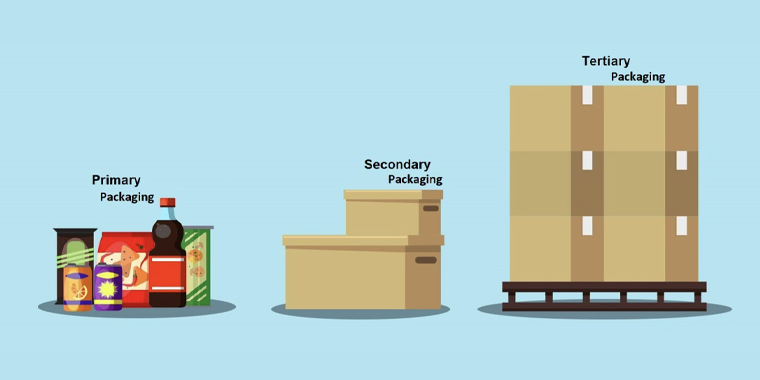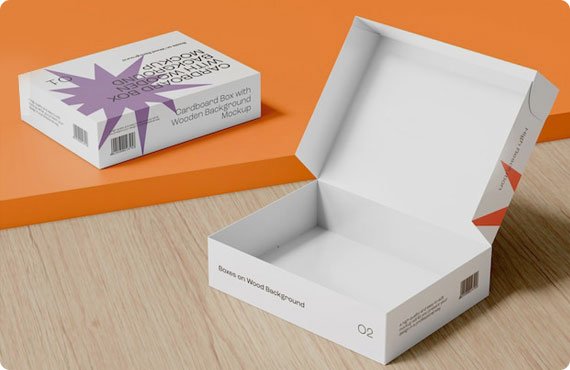March 05, 2025

Packaging has three tiers: primary, secondary, and tertiary packaging. Collectively, they contribute to growing the business. Irrespective of the fact that it is new or established.
Primary packaging houses the exact products, secondary packaging makes groups of those products, and tertiary packaging is the outer layer that ensures the safe delivery of the products. Businesses focus on this type of packaging to increase their efficiency.
Knowing about tertiary packaging is essential if you are a business owner or aspire to start one. This blog post will explore tertiary packaging, its types, and applications. So, Let's kick off our discussion!
If you are thinking about the definition of tertiary packaging, it's the final layer of packaging. The tertiary packaging market transports large quantities of goods. It is also known as bulk or transit packaging. It is designed to keep your products safe from external factors.
This packaging is available in different forms. Some common examples include:

The following are the most common types of this packaging in the market:
It includes wooden crates, metal drums, and hard plastic containers. These are used for heavy goods.
It contains stretch films and shrink wraps that are used for lightweight items.
This includes foam inserts and air cushions. They help to safeguard delicate products.
It consists of large sacks and barrels for liquids and granulated products.
Let’s review why it matters. The following are the reasons:

Tertiary packaging is used for a wide range of products, some of which are discussed below:
It ensures that medicines and medical supplies remain safe. Bulk shipments of drugs are packed in large cartons to maintain their integrity.
For delicate items like beverages, glass bottles, insulated containers, and pallets are used. For example, when Coca-Cola ships their cases, they are stacked on pallets and then wrapped in plastic.
Large businesses use corrugated boxes to keep products safe for shipping. For example, biscuits are packed in cartons and placed on pallets for transport.
For agricultural goods such as fruits, this packaging is used for distribution on a larger scale. Sacks and crates help in safe transport.Electronics and Machinery
Fragile electronic items require strong cartons to prevent damage. Pallets with foam inserts are commonly used.
This packaging provides many benefits, but it also has some drawbacks. Let’s review them to understand it completely:
1. Minimizes Product Damage
It reduces the chances of breakage or leakage.
2. Enhances Efficiency
This type of packaging allows easy stacking and transportation.
3. Reduces Packaging Costs
Packaging in bulk reduces the need for excessive secondary packaging.
4. Supports Automation
This packaging is highly compatible with warehouse automation systems.
5. Greener Options
Many tertiary packaging materials are recyclable and biodegradable.
1. Increased Material Use
Additional materials like pallets and shrink wraps are needed.
2. Higher Storage Requirements
This packaging is bulkier, so it needs more warehouse space.
3. Environmental Concerns
Some materials are not eco-friendly and contribute to waste.
4. Added Costs
It increases packaging and shipping costs for new businesses.
5. Complex Recycling Process
Some tertiary packaging materials require special recycling processes.

Secondary packaging makes groups of primary packages. It includes boxes and wraps for display. These are essential for branding and presentation purposes in the market. Tertiary packaging is designed for bulk transport. It includes pallets and crates.
To maximize the benefits of tertiary packaging, businesses should focus on:
Using durable and recyclable materials can enhance efficiency.
Consistent packaging sizes improve stacking and storage efficiency.
Packaging systems can speed up the process and reduce labor costs.
Minimizing excess packaging materials can lower costs and environmental impact.
Technologies such as QR codes can improve traceability.
Companies are shifting towards greener alternatives. Some emerging trends include:
Also read: What Is Frustration-Free Packaging? Improved User Experience And Boosted Convenience
Tertiary packaging is essential to optimize supply chains. It protects products and reduces costs. Businesses across various industries rely on it for safe transportation and storage.
At Custom Designs Boxes, we specialize in providing excellent quality tertiary packaging solutions that meet your needs. These include folding cartons, corrugated boxes, and many more.
Contact us via email today at sales@customdesignsboxes.com to optimize your packaging process with reliable and sustainable options.
Find the perfect packaging solutions tailored to your industry niche.
Don't just imagine – experience excellence up close, as you can check our superior craftsmanship before making your decision by ordering your sample kit.
